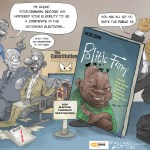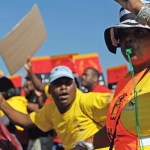Cast your mind back briefly to the heady days of 2009. What salad days they were. At that point, things were flying, but danger loomed. The SA economy was just about to be caught up in what was to become the great global recession.
But as it happens, the extent to which it would affect SA economically was at that point not really clear. In the longer span, SA had just had a decade of above-average growth. Confidence was high. The government’s coffers were overflowing, so much so that an incredible thing happened. One year, the government actually spent less than it took in. Crazy!
The national debt was coming down — and gradually, the surplus gained by having to pay off less debt was being spent on expanding social services. The African National Congress had astounded the world by being a prudent, careful government financially speaking, despite fiery leftist rhetoric at every public occasion.
What happened then was a kind of internal coup; the coalition of the spurned in the party had their revenge. The trade unions, impatient for real change, allied with the left-wing economists, frustrated with “austerity economics”, who allied with, well, there is no other name for them, the looters. They came together to oust the ancient regime. Then-president Thabo Mbeki was booted, the 2009 election was won, and Jacob Zuma was ushered in to much acclaim
Economically, however, the country took a terrible turn for the worse. The global recession hit hard in 2010, and growth plummeted. Hence emerged a new economic consensus: The SA government should spend like a Kardashian at Hollywood molly party. The government should “lead” the economy, and everybody should fall into line, including those pesky private sector businesses, just as those dutiful Chinese corporations do.
All members of the coalition of the spurned had a stake in this process. No more “austerity” economic policy for the left-wing economists. No more circumspect increases for public servants, which pleased the unions. And no more parsimonious government contracts for the looters.
But the coalition extended further. Conventional economists agreed that “leaning against the (economic) wind” was prudent. After all, the government had paid down its debt precisely for this kind of emergency. The government needed to step in, which it did.
At this point, however, something odd happened. Emerging market countries around the world rebounded and even grew. But SA didn’t. In fact, it got worse. Economic growth kept on surprising on the low side. Treasury’s growth estimate at the budget time was not realised every year for a decade. As a result, the government has had to take a series of emergency measures, including increasing taxes, tariffs and excise duties on petrol and cigarettes and everything else. But each time it did so, it added gloom to the economy.
And increasingly, it tapped the debt markets. And that’s even before we start talking about Eskom and Transnet, and so on.
As they say, a billion here and a billion there, soon you are talking about real money. In a decade, SA dropped R1.5-trillion. SA’s national debt is now R3.16-trillion. Just paying off that debt costs government just under R500-million a day.
Some economists have suggested SA should continue borrowing. The country’s debt is, after all, not out of line with other emerging market countries. Which is true, but their debt is static or coming down, not going up at a furious rate. SA should have huge, new infrastructure projects. New investment. New efforts. The government should “take the lead”.
Yet, this is exactly what they were arguing a decade ago. It didn’t work then; and now? Well, the situation is just not the same. SA’s businesses are under enormous strain. Private sector credit extension has been flat for seven years. The savings rate, never great in the first place, has come down from 18% of GDP to around 14%. House prices have, everywhere other than the Western Cape, shown only incremental increases for a decade.
So what did happen there? Answering this question could help answer what Ramaphosa should be doing now.
Economist John Ashborne at Capital Economics says if you look long term, SA debt problems are more the result than the cause. It’s just become harder and harder to fund the economy as it slowed down.
The commodity price boom in the 2000s obscured some structural problems, and when that tailwind was removed “things slowed down quite a bit”.
The most obvious of these was SA’s low savings rate. Growth has traditionally come from consumer spending, which hasn’t done much to establish future growth. The sectors that were the backbone of the economy during the apartheid era, mining and manufacturing, have declined dramatically and have been replaced by the banking and service sectors. But these are comparatively small, so they haven’t been able to replace what was lost in mining and manufacturing, he says.
All the failings of Zumanomics fall more or less into this category; huge public sector wage increases; throwing money at problems for grand purchases of foreign goods such as railway stock; increasing social spending when there is no money to pay for it; allowing bad actors to infiltrate project spending and cream off small mountains of boodle. All this we know.
So coming back to the key question: What does the failure of the economics of the spurned tell us about where Ramaphosa should head now?
They might be summarised thus: Boosting growth through consumer spending is a short-term fix, like drinking a fizzy drink. You feel better, but it doesn’t last. What the economy needs is energy drinks. What provides a permanent fix are slower, longer-term, more difficult challenges focused on building piece-by-piece.
And speaking of Eskom… BM


















 Become an Insider
Become an Insider